T8 LED lamps: characteristics, comparison with fluorescent lamps + best manufacturers
If the fluorescent tubes in the ceiling lamp have burned out and you want to save money by installing LEDs, then it is not necessary to change the lighting fixture.It is enough to install T8 LED lamps in it, which are specially designed for the G13 socket-socket.
We will tell you how to find the best option for a linear diode light bulb. We'll show you how to install it by slightly modifying the power supply circuit by removing unnecessary elements from it. Taking into account our advice, you can easily improve your lighting device without any expense or special effort.
The content of the article:
Design and types of T8 LED tubes
Lighting in offices and public buildings today is most often made of lamps with fluorescent fluorescent lamps. Moreover, for the most part these are compact “squares” on the ceiling with mercury tubes for the G13 base.
These lighting fixtures are standardized to the dimensions of 600x600 mm Armstrong-type ceiling systems and are easily built into them. Fluorescent tubes were once widely used to save energy. In public structures and buildings, lights are often turned on 24 hours a day.
Conventional incandescent lamps quickly burn out in such conditions and consume too much electricity. Luminescent analogues are 7–10 times superior in durability and 3–4 times more economical.
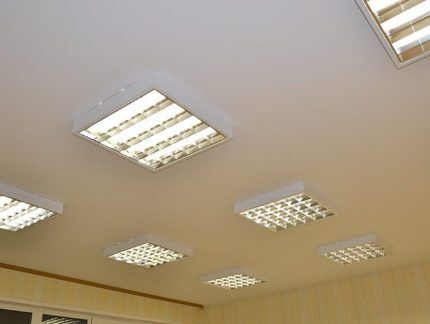
However, technology continues to develop, and LEDs are gradually replacing tubes with harmful mercury.This new product is even more durable and consumes an order of magnitude less electricity than old light bulbs with a tungsten filament.
“LED” (Light-Emitting Diode) outperforms competitors in all characteristics. The only drawback of such LEDs is their fairly high price. But it is also gradually decreasing as the market for LED lamps develops.
The T8 LED tube is identical in appearance and size to its electroluminescent counterpart. However, it has a fundamentally different internal structure and a different power supply principle.
The LED lamp in question consists of:
- two G13 swivel bases;
- diffuser flask in the form of a tube with a diameter of 26 mm;
- driver (power supply with overvoltage protection);
- boards with LEDs.
The flask is made of two halves. One of them is an aluminum base-case, and the second is a light-diffusing shade made of transparent plastic on the back. This design is much stronger than conventional glass tubes containing mercury. Plus, aluminum perfectly removes the small heat that is generated during the operation of LED elements.

To power the LED, you need a constant voltage of 12–24 V. To transform the alternating current from which the lamps are powered, the lamp is equipped with a power supply (driver). It can be built-in or external.
The first option is preferable, as it simplifies installation. If the handset has a built-in driver, then you just need to insert it in place of the old one. And in the case of a remote power supply, it will still need to be placed and secured somewhere.
It is recommended to choose an external option only when completely replacing all lighting. Then such a power supply allows you to save a lot; several tube lamps can be connected to it alone.
The number of LEDs on the board can reach several hundred. The more elements, the higher the light output of the lamp and the more powerful it itself. But a lot depends on the size of the tube.
T8 LED lamps come in lengths of:
- 300 mm.
- 600 mm.
- 1200 mm.
- 1500 mm.
Each option is designed for its own type of lamps. There is a tube for any size of lighting fixture, both for the ceiling and for desktop models.
Which is better: LED vs fluorescent
When compared with other lamps, LED lamps greatly benefit in terms of efficiency. However replacing fluorescent tubes with diodes is associated with a number of problems. You cannot simply insert an LED into a lamp in place of a gas-discharge bulb.
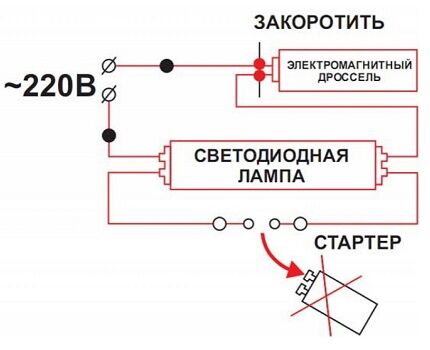
Before installing T8 LED tubes in a luminaire originally designed to connect fluorescent lights, it is necessary to remove the starter. If the LED lamp has a built-in driver, then it only needs direct power from a 220 V network.
But the circuit also contains ballast (choke). Some tubes with LEDs are compatible with it. They may well work without removing this element. In this case, you only need to unscrew the starter.
However, there are modifications linear LED lamps, for which ballast load is completely unnecessary and even contraindicated.It also needs to be removed by connecting the wires at the site of the gap. Such alterations lead to the fact that after putting the fluorescent tube back it becomes impossible.
In this case, usually no marks are made on the lamp body about these modifications to the power circuit. As a result, a new electrician comes in and for one reason or another inserts a fluorescent light. And this is a direct path to problems in the electrical network.
Plus, measurements show that those connected via throttle T8 LED lamps can lose up to 20% energy efficiency. This is additional wasted electricity. Moreover, a lot depends on the manufacturer. Some reduce these losses to almost zero, increasing the cost of the product, while others simply do not mention them on the packaging.
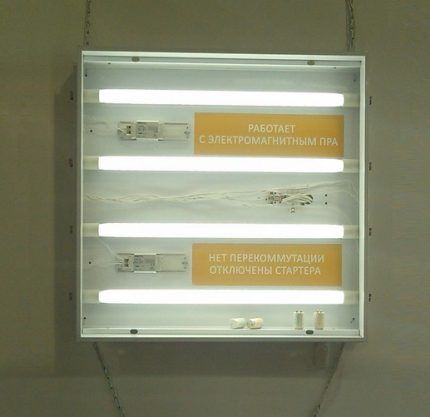
It is best to initially choose a tube designed for direct connection. Then you will only need to remove everything unnecessary from the lamp and make notes on the lighting fixture about the changes made. This is a more difficult solution to install, but not so problematic in the future.
In general, replacing T8 fluorescent lights with LED lamps of similar sizes has a number of advantages:
- Energy savings, consumption is reduced by 50-80%.
- Longer service life (manufacturers claim 5–6 years of continuous operation, but practice speaks of 3–4 years).
- No flickering effect.
- No dangerous mercury vapor.
- Higher light output.
Almost all models of T8 LED tubes have a narrow luminous flux of 180 degrees.The luminescent opponent, on the contrary, shines in all directions, losing most of the light that is directed upward directly into the body of the ceiling light fixture.
Connection diagrams for G13 lamps with LEDs
The fluorescent tube starting system is built on the basis of an induction electromagnetic (ballast) or electronic ballast (electronic ballasts). If a T8 LED lamp is connected through them, then it must be designed to work with these circuit elements.
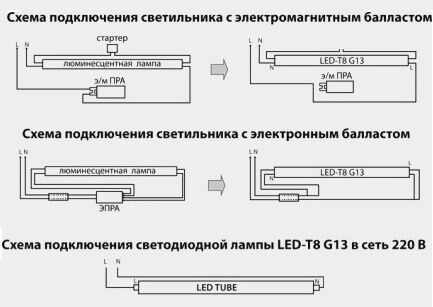
There are two basic schemes for connecting new LED lamps instead of fluorescent lights:
- Directly to the 220 V network with complete removal of the starter and ballast.
- Through the electromagnetic ballast present in the lamp.
The first option is further divided into a couple of subtypes depending on the presence of an internal or external power supply. If the power supply is built into the LED tube, then you just need to insert it into the connectors. And if the lamp is designed for 12 V power supply, then a separate power supply will have to be mounted somewhere nearby, and then the wiring will be connected through it.
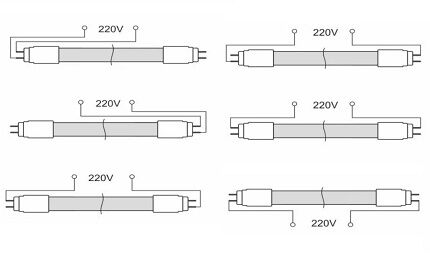
Installation is simple. In most cases, simply inserting a new tube in place of the old one is enough. The main thing is to choose it correctly.
If you purchased a simple linear model without the ability to connect via a starter, you will have to tinker with the wires. It’s not enough to remove the ballast and starter; you also need to short-circuit these break points.And short wires in such lamps are often not designed to be pulled together; inserts have to be made.
General criteria for choosing LED lamps
In order to choose the T8 LED tube correctly and not regret it later, you need to carefully study all the inscriptions in the product labeling. Everything is described there in detail, you just need to understand all these numbers and characteristics.
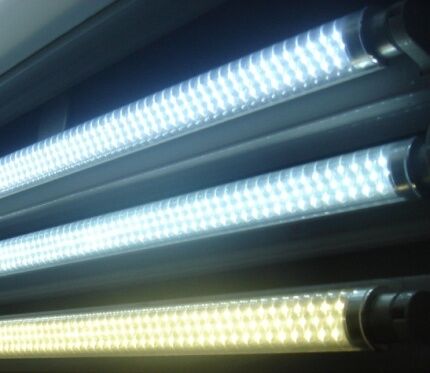
According to the color of light (color temperature) LED lamps are divided into three groups:
- “Warm White” Warm White (2700–3300 K).
- “Natural white” Neutral White (3300–5000 K).
- “Cold white” Cool White (>5000 K).
For offices, it is recommended to choose the third option with invigorating light. And for the home, the first one with a “warm” yellowish tint is more suitable. Such light bulbs will not “load” your vision with excessively bright light.
The second important parameter is light output (luminance intensity). The more lumens indicated in the passport of a T8 LED lamp, the more LED chips it costs. But the brighter it will shine, which is not always useful.
When choosing based on this indicator, you need to focus on old fluorescent light bulbs. The new ones should not exceed them too much in light intensity.
The third important figure is the degree of color rendering (Ra or CRI). At the maximum it can be equal to 100. This is the reference natural light from the sun. But such lamps are more intended for spot lighting of desktops, where distortion of the colors of objects is unacceptable. For conventional luminaires, Ra in the range from 80 to 90 is sufficient.
In terms of power supply, LED lamps can be designed for 12–24 or 220 V.The former require an additional power supply, while the latter have it already built into the handset body.
By degree of protection IP20 or IP21 is sufficient for office installation. There is no particular dust or moisture in such rooms. If you want to take it with a reserve, then IP40 will do. Other models with high IP will cost too much, and there is zero need for increased protection in domestic conditions.
Review of LED tube manufacturers
In recent years, the LED technology market has been booming. The number of brands and manufacturers is growing exponentially.
This leads to a gradual reduction in LED prices in stores. However, these processes are not always beneficial for the average buyer, since there is a high risk of running into a frankly low-quality product.
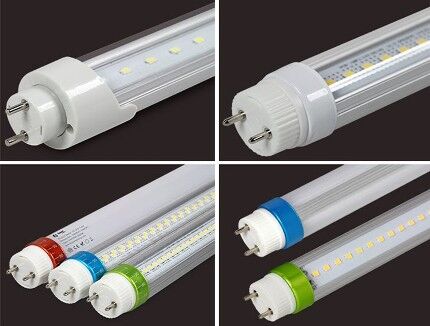
Among the numerous manufacturers of T8 LED lamps, the following are well-deserved trust:
- From the European-world - "Gauss", "Osram" And Philips.
- Among the Russian ones are “Optogan”, “Navigator” and “SVeto-Led” (“Newera”).
- Among the proven Chinese ones are “Selecta” and “Camelion”.
The price of LED tubes for ceiling lights largely depends on the region and the specific seller. Plus, the characteristics of the model also play a significant role.
Before you buy this or that option, you need to carefully study the labels on the packaging.
Find out what to do with an old fluorescent device after replacing it. next article, dedicated to the disposal of devices containing mercury.
Conclusions and useful video on the topic
There are many nuances in choosing an LED tube for the G13 base.To make it easier for you to understand their range, we have made a selection with reviews of individual models and analysis of connection diagrams.
Video #1. Converting a fluorescent lamp to LED:
Video #2. Review of a linear LED lamp with a description of the device and connection principles:
Video #3. All the features of installing an LED tube instead of a fluorescent one:
The popularity of LED lamps is growing; they are beneficial from all points of view. To replace standard “daylight” tubes with them, you only need to remove a number of unnecessary elements from the power circuit. The T8 LED lamp was originally designed for G13 socket connectors. There should not be any particular difficulties with its installation.
Please write comments in the block below. Tell us about how you selected linear diode lamps for lighting or decorating a suspended ceiling. Ask questions, post photos related to the topic of the article.




LED lamps have many advantages compared to other types of lamps - a much longer service life, low energy consumption, a large selection of colors, and minimal heat generation. Although the only downside is the high price. And even considering that during the operation of the LED lamp, you would have changed several fluorescent or incandescent lamps, this is a debatable minus.
It’s not entirely clear why reinvent the wheel and dismantle the old system if you can buy a base specifically designed for LED lamps? Is this a form of masochism?